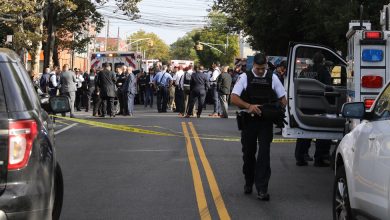The Last Days of an Outback Town Where Every Breath Can Be Toxic

WITTENOOM, Australia — Sitting on a roof in a ghost town in the middle of the Australian outback, Mario Hartmann waited for the bulldozers to come.
He climbed up every day because it was the only spot to get an internet signal. With the nearest town an hour and a half away, he knew he must be careful. “I go, you can only have 15 beers,” he said. “More than 15 beers, you don’t come up here.”
But far worse risks haunt this town. In the yard below, Mr. Hartmann’s Australian sheepdog scampered after a ball, kicking up dust clouds laced with an invisible threat: blue asbestos. Just one breath can send the fibers coursing into someone’s lungs, triggering an aggressive, incurable cancer. That is why the government is about to wipe this town, Wittenoom, off the face of the earth.
Mr. Hartmann, 59, paid none of this any mind. He swept a hand out at the panoramic view of sun-bleached fields and red mountain ranges beyond the town, his vacation home now and forever.
“How beautiful is this, hey?” he said.

Mario Hartmann, one of the last two people living in Wittenoom, in the kitchen of a friend’s former home. Mr. Hartmann sold his property to the government a few years ago, but he still returns for several months each year.Credit…Matthew Abbott for The New York Times
Once a symbol of economic prosperity, Wittenoom now stands as one of Australia’s greatest industrial tragedies, left uninhabitable by the actions of unaccountable mining interests and neglected by a government that has done nothing to clean it up.
The town was built long ago on skyrocketing demand for asbestos products like coatings and insulation, with the promise of economic development overshadowing emerging health concerns. Of the 20,000 people who have lived in the town or worked in the nearby mine, 2,000 have died of asbestos-related illnesses.
Wittenoom became a carcinogenic time bomb as mining waste products known as tailings were brought into the town, paved into roads and scattered in playgrounds and gardens to suppress dust. Near the mine, the tailings — more than three million tons — were left piled up like mountains and left to stream down gorges.
Sixty years after mining ceased, the Western Australian state government says the health risk remains unacceptably high.
For over a decade, it has tried to close down Wittenoom to stop thrill-seeking tourists from visiting. It removed the town from official maps and shut off water and electricity. It tried to buy out the residents. When that failed, it passed a bill this year to acquire the remaining properties by force.
In the process, it turned the handful of residents who refused to leave into symbols of dogged self-determination, fighting for the right to roll the dice on their own lives.

Mounds of asbestos tailings from the Wittenoom mine, which closed in 1966.
But at the beginning of September, the two people left were nearly ready to give up the fight. One was Mr. Hartmann, who accepted the buyout a few years ago but still returned for several months each year.
An immigrant who combines a rolling Austrian accent with an Australian’s proclivity for swearing, he left when the town, hollowed out and vandalized, lost all resemblance to the place he’d first made his home 30 years ago.
He isn’t blind to the danger of his yearly return trips in his camper. But he accepts it easily, seeing it as out of his control. “Some people get it, some people don’t,” he said of asbestos-related cancer. “It depends on your makeup.”
To live in a place like Wittenoom requires a belief in an immovable future. Mr. Hartmann sees his fate with an inevitability that absolves him of doubt over his own choices, which is why he can say with certainty that if living in Wittenoom eventually leads to his death, “I wouldn’t regret being here.”
Toxic Legacy
Maitland Parker, who grew up on Wittenoom’s outskirts during its heyday, remembers clouds of dust rising from a mine pumping with activity. Aboriginal children like him used to hitch rides atop the trucks transporting asbestos fibers, he said. His brother remembers chewing on the tailings like gum.
But it would take decades for people to realize what they had been breathing in. “We never had a clue, really,” Mr. Parker said.
When he visited Wittenoom one August afternoon, he put on a mask.
Mr. Hartmann ribbed him about it. “What’s with the mask, huh?” he said. Mr. Parker has already been diagnosed with mesothelioma, a cancer caused by asbestos exposure.
This is part of the randomness of Wittenoom’s devastation. While many who worked directly with the asbestos did not develop cancer, Mr. Parker did so even though he never lived in the town or worked at the mine.
Mesothelioma can be treated but not cured, and life expectancy after diagnosis is typically one to two years. But Mr. Parker, 69, is still going strong after receiving his diagnosis in 2016.
“I’m still alive. I should be dead,” he said. With the time he has left, he has made it his mission to have the contamination cleaned up.
After the mine closed, no moves were made to rehabilitate the land. The Banjima people, who have lived around Wittenoom for thousands of years, were left with its legacy. They still go to the mountain ranges and gorges near the town. They have no choice, they say; it is their cultural and spiritual obligation.
But every time they do, they make the impossible choice between their way of life and their health. Western Australia has one of the highest rates of mesothelioma in the world, and the rate among the state’s Aboriginal population is higher still.
Mr. Parker said responsibility lay with the Western Australia government. “At this point, they don’t care about the suffering,” he added.
Mr. Parker and others connected to Wittenoom believe that the closure of the town will herald a restarting of mining in the area. They fear that the warnings about industrial hubris that the town symbolizes will be paved over by the same industry that destroyed it once before.
Gina Rinehart, the richest woman in Australia, whose father mined asbestos in Wittenoom, plans to mine iron ore just outside the contamination zone and has also explored mining within it.
The pain Mr. Parker feels with every breath is a reminder that his time is running short. But “while I’m still kicking and I can still breathe and argue for my country to be cleaned up,” he said, “well, then, that’s what I’ll be doing.”
Last One Standing
One well-maintained house stands out among the wasteland of rusted oil drums, toppled signposts and boarded-up windows that is Wittenoom.
By the front door, a polite warning, scrawled into clapboard in a tidy script, greeted visitors: “Please keep out. People still living here. Thank you.”
One person, actually. Inside, Lorraine Thomas, Wittenoom’s last resident, was packing up 40 years’ worth of belongings into cardboard boxes and bins: antique furniture, reams of papers and documents, clothing whose owners had left long ago.
“These are things I’ve collected around,” Ms. Thomas, 80, said.
It was a slow process. She had missed one deadline to leave in June, and another on Aug. 31. At the beginning of this month, she was waiting to see if the authorities would remove her by force.
As she counted down the days, her mind turned to the memories she’d made in the town, where she moved with her three young daughters after the death of her first husband. It was in Wittenoom that she met her second husband, Lesley, and built a life with him running a gem and tourist shop.
She recounted those memories again and again, as if she could see still them playing out through her windows — gas stations, schools and motels superimposed over vacant lots and knee-high grass.
“I don’t know,” she mused. “Life should be a bit different.”
Even after her daughters left, her husband died, the town disappeared and her home caved in around her, she vowed she’d never leave, unwilling to part with a place that had become a memorial to a happier time and a fuller life. To stick around, she had to be eminently self-sufficient; when she locked herself out of her home recently, she broke a window to get back in.
But as her health declined, she admitted she couldn’t stay forever.
On Sept. 8, the inevitable happened: Sheriff’s officers arrived unannounced and evicted Ms. Thomas.
Mr. Hartmann has also left under government orders, taking his camper to a nearby gorge to spend the rest of his vacation.
And Mr. Parker will continue to wait to see if the lessons of Wittenoom are ever learned.




